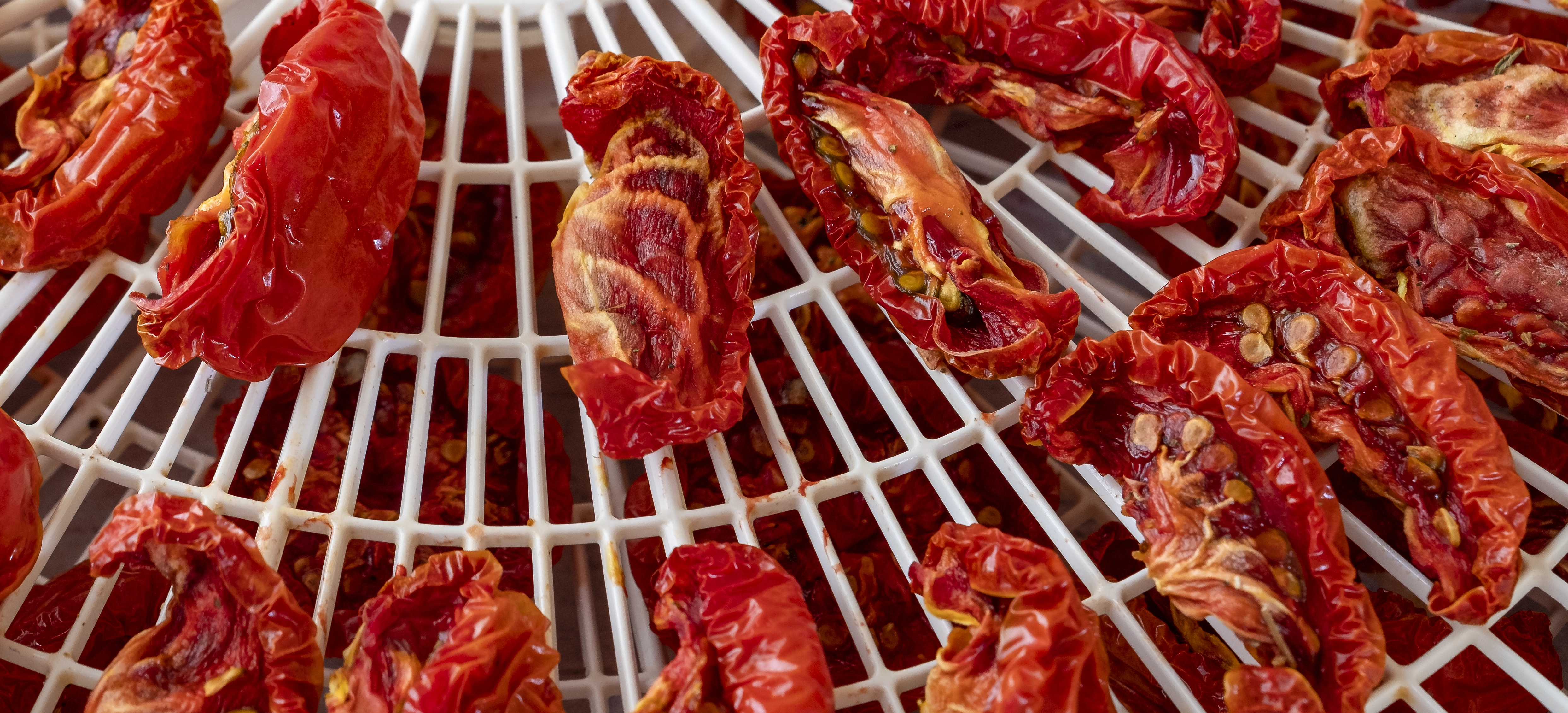Semi Dried Tomatoes in Oil
- Recipes
- Drying, Salting & Potting

Summer and tomatoes are perfect partners. Capture tomatoes complex, sweet, sour, salty, fruity and floral flavour in this summer/autumn preserve that radiates joy from the jar. While they are abundant semidried tomatoes are a must - must do. The slow drying process intensifies the flavour bringing sunshine, happiness, and an explosion of flavour to the table.
Colourful, versatile and simple to use, semi dried toms can be added, sliced or whole, to pizza, salads, sandwiches, focaccia or your favourite bread alternative, anti-pasta platters, pasta, risotto and gnocchi, and in soups and stews. Preserved in olive oil, which further enriches the flavour, the left over oil is a wonderful bonus to use in marinades, dressings and to sauté.
Preserving under oil, which seals the tomatoes from air and bacteria is a traditional technique used in Italy known as pomodori secchi sott’olio.
- Preparation Time:
- 20 minutes
- Quantity:
- 2 x 300 ml jars
- Drying Time:
- 8 hours
INGREDIENTS
- 2 kg
- Ripe tomatoes
- 2 tablespoons
- Cooking salt
- 2 tablespoons
- Dried herbs, optional
METHOD
Gently wash and dry tomatoes to remove garden or shop debris.
Insert a small sharp vegetable knife a short distance from the stem. Using a slight inward angle, cut in a circular motion all the way around the stem. Repeat the process until the stem has been removed from all the tomatoes.
Cut tomatoes in half and sprinkle with salt. If they are larger than 5 cm (2 inches) in diameter, slice into quarters.
Use either the Dehydrator, Oven, or Sun Drying Method below until the tomatoes are semi-dried. Then proceed to STEPS 3 & 4 to complete the preservation process.
Dehydrator Method
Turn on the dehydrator and set to 60 degrees C.
Place prepared tomatoes directly onto the dehydrator trays. Space evenly making sure they are not touching or overlapping. The free movement of hot air is required otherwise the drying process will be inhibited.
As each tray is filled, place on the dehydrator, cover, and commence drying. After 2 hours turn down to 55 degrees C until the tomatoes are semi dried. Turn over the slices a couple of times during the drying process.
The initial hotter temperature will help to evaporate the extra moisture generated during the first stage of drying while the cooler temperature will minimize the loss of heat-sensitive vitamin A and C.
Do not turn off the dehydrator and leave partially dried food sitting on the trays overnight as the tomatoes can spoil and/or develop off flavours.
Do not add fresh tomatoes to a partially dried batch as this will slow down the drying time.
Oven Drying Method
Pre heat oven to 140 degrees C or 120 degrees C fan forced. Line a baking tray with baking paper.
Place prepared tomatoes directly onto the baking trays. Space evenly making sure they are not touching or overlapping. The free movement of hot air is required otherwise the drying process will be inhibited.
Bake for 2 – 4 hrs, or until the tomatoes are semi-dried. Turn the tomatoes over a couple of times during the drying process.
Drying Method
Sun drying is one of the oldest forms of food preservation. The right climatic conditions (1) minimum 30degrees C /86 degrees F, (2) dry, the less humidity there is the better and (3) with a consistent breeze, over a minimum of 4 days and hygienic practices are critical for success. Place the prepared tomatoes on hygienic shelving which provides good air circulation and cover with continuous netting to prevent birds, insects, and garden debris from contaminating the produce. Place in the sun, turning over a couple of times during the drying process, until the tomatoes are semi-dried.
Bring inside overnight, if the weather cools or it rains to prevent the reabsorption of moisture.
If changed weather conditions prolong the drying process, revert to the Dehydrator or Oven method to complete the process. The tomatoes can spoil, developing moulds or off- flavours if the drying process is too long.
This is not my preferred method as weather can be uncontrollable making this form of drying the riskiest.
Now the tomatoes are semi dried allow to cool, then layer in a sterilised container to 5 cm (2 inches) from the top of the jar. Slowly pour in good quality olive oil until the tomatoes are completely covered. Using a blunt knife or metal skewer, remove any air bubbles.
Seal immediately with sterilised lids, label, and store in the fridge.
Use within a couple of months and once opened always make sure the tomatoes remain covered with oil and only use clean utensils, never fingers, to remove them.
NOTES
- Kitchen hygiene, sterilising jars and lids, using scrupulously clean metal utensils and hands and keeping the semi-dried tomatoes in the fridge are an absolute must. The tomatoes and oil can be easily contaminated, which will cause rapid food spoilage
- Dehydration times are an approximation only. The size and thickness of the fruit, its moisture content and the air humidity will influence the drying time.
- Use good quality olive oil as it infuses the tomatoes with its flavour.
- Use only dried or preserved items such as capers, olive, or preserved garlic. Adding fresh herbs or fresh cloves of garlic can increase the risk of food borne botulism which can cause serious health problems, and on rare occasions death.
- To flavour the semi-dried tomatoes, alternate tomato layers with dried herbs such as basil, oregano, marjoram and/or thyme or capers, preserved pitted/ sliced olives or garlic.
